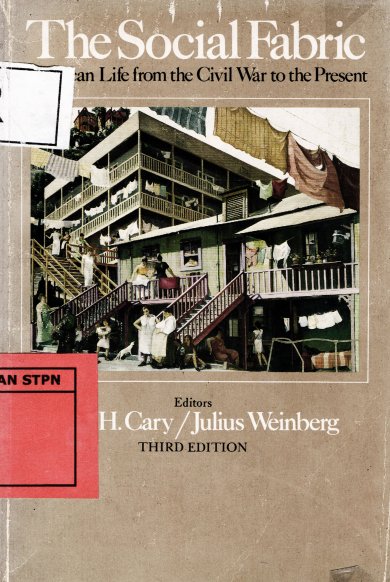
PERPUSTAKAAN STPN

| Pengarang | John H. Cary |
| Penerbit | Little Brown And Company |
| Tempat Terbit | Toronto |
| Tahun Terbit | 1978 |
| Bahasa | Inggris |
| ISBN/ISSN | 0-316-130745 |
| Kolasi | x, 355 hlm.: ilus.; 26 cm |
| Subjek | Sosial Fabric |
| Media | Buku |
| Abstrak | |
I know histhry isn't thrue Hinnessy, because it ain't like what I see ivry day in Halsted Sthreet. If any wan comes along with a histhry iv Greece or Rome that'll show me th' people fightin', gettin' dhrunk, makin' love, gettin' mar-ried, owin' the grocery man an' bein' without hard-coal, I'll believe they was a Greece or Rome, but not befure. The sentiment of Mr. Dooley, Finley Peter Dunne's comic Irish philosopher, expresses the attitude of many people toward history. Young Americans, especially, question the relevance of a history that deals only with politics, diplomacy, governments, and famous leaders, and ignores the daily life of average men and women. Two recent trends, however, are doing much to remedy this neglect. One is increased popular interest in the forgotten mass of men and women who tilled our fields, built our cities, and fought our wars, but who achieved no particular fame and left very little record of their lives and thought. The second development is the renewed concern of historians with social history. This kind of history has more meaning for us, and touches our lives more directly, than any other aspect of our past. In an afire seeking "relevance" nothing is more relevant than American social history. Each of us has direct experience, or an intimate awareness, of being part of a family, of falling in love and marrying, of poverty and pain, of suffering in war, of earning a living, of social oppression and reform. By understanding the social life of an earlier age, we can gain an understanding of ourselves and of others, in whatever time or place they lived. This is an anthology of American social history for college history courses. It began with our belief that college students would find more meaning in the kind of history described by Mr. Dooley than in political, diplomatic, or constitutional history. This and the companion volume of , which covers the period from the earliest settlement of America to the Civil War, touch upon marrying and making love, fighting and getting drunk, owing the grocer, and going without heat. Covering the time from the end of the Civil War to the present, this volume contains descriptions of the segregation of southern blacks during Reconstruction and the way of life of whites on the Middle Border at the turn of the century, labor's efforts to organize in the coal mines of Pennsylvania, the impact of Prohi-bition on both gangsters and respectable Americans, the Great Depression of the 1930s, and the counterculture of the 1960s. No single book can treat every aspect of our history, but these volumes examine American life in much of its diversity. There are essays on women as well as men; on Indians and blacks as well as whites; and on the poor and the oppressed as well as the rich and the powerful. The sectional, class, racial, and religious differences among our heterogeneous people have created serious strains that at times threatened to tear the nation apart. But with all their diversity, the American people have also shared many common attitudes and traditions that provided a common social fabric to bind them together. We have selected the readings from some of the most interesting writing on the American past. We have prefaced each reading with an introductory note, explaining the relation of the subject to broader developments in American history of the period. Each selection is also accompanied by an illustration, which provides a visual commentary on the topic under con-sideration. The study guide that follows the selection will help you review the special aspects of the reading, and may suggest issues for class discus-sion. The bibliographical note will help you find further material, should you wish to read more on the topic. The third edition of volume 1I of retains many of the best readings of the earlier editions, with seven new selections. A num-ber of them replace � and, in the opinion of the editors, improve on- essays on the same topics included in the first two editions; others � on the mores of college youth and on bootlegging in the 1920s, and on the tragic shootings at Kent State � take up topics not previously covered. The response of student's and teachers in both four-year colleges and com-munity colleges to this anthology has been most gratifying. A number of teachers who used the earlier editions of in introductory cour$c$ have indicated that these volumes rank with the most successful supplementary materials they have ever used. Many of them eontiibuted suggestions, as have a number of students, which have been incorporated in this new edition. We have appreciated the coinincnts that students have made on the evaluation form that appears as the last page of each volume. J.C, J.W. | |
| Nomor Rak | 330 - T | ||||||
| Nomor Panggil | 338 Car t | ||||||
| Lokasi | Ruang Baca | ||||||
| Eksemplar | 1 | ||||||
 PENCARIAN RFID PENCARIAN RFIDPencarian koleksi menggunakan RFID akan membantu mempercepat menemukan koleksi di rak buku. Gunakan fitur ini jika mengalami kesulitan dalam menemukan koleksi di rak buku. Untuk menggunakan fitur ini silahkan klik salah satu Tombol Pesan diatas kemudian hubungi Petugas Pelayanan Sirkulasi dengan menyebutkan Judul Bukunya. | |||||||